Year: 1982
Directed by: Steven Lisberger
Written by: Steven Lisberger, Bonnie MacBird
IMDB Reference
Degree of Cyberpunk Visuals: High
Correlation to Cyberpunk Themes: High
Key Cast Members:
Kevin Flynn/Clu: Jeff Bridges
Alan Bradley/Tron: Bruce Boxleitner
Ed Dillinger/Sark/Voice of Master Control Program: David Warner
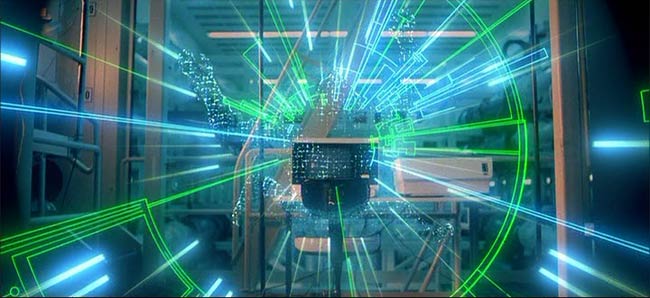
Overview: How could a cyberpunk review site NOT have Tron? We’re talking about the first CG movie, and truly, a groundbreaker VR movie. Make no mistake, this is a pre-cyberpunk movie, complete with corporate greed, theft, integration of human and computers, ubiquitous access to information, a dystopian world (inside the program, anyways), and pure cyberpunk visuals and style. While Tron is slightly cheesy in parts, its still a hell of a ride!
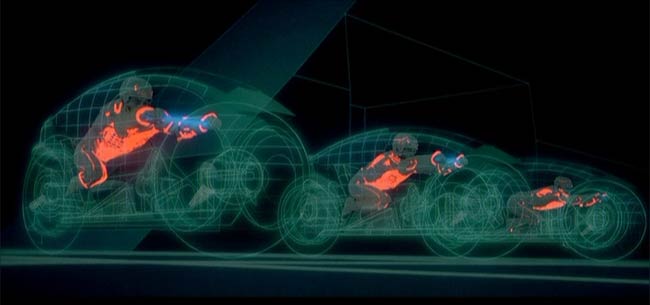
In Tron, a computer programmer (Jeff Bridges) who has his programs stolen from him tries to go back into the corporation to get them, but somehow gets sucked back into the game he developed. From there the fun begins, as Bridges has to square off against contestants and the Master Control Program in order to escape back to the real world. Most of this adventure takes place within the program world, and involves some awesome games and fun chase scenes.
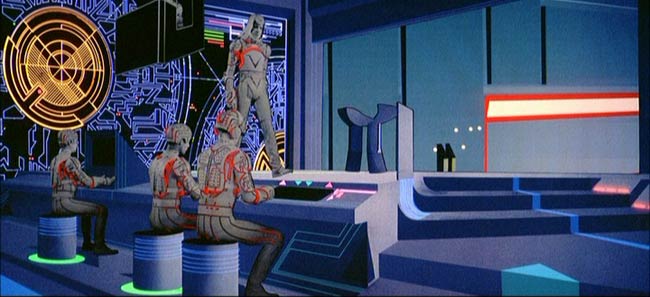
Like the Wizard of Oz before, and eXistenZ and Thirteenth Floor after it, the players in the game bear a striking resemblance to their human users. Some movies call this “residual self image” - others just build this concept into the design of the system. But while this convention existed in fantasy realms, Tron successfully set the pattern for most future VR films - you look the same on the inside of the VR system as you do on the outside.
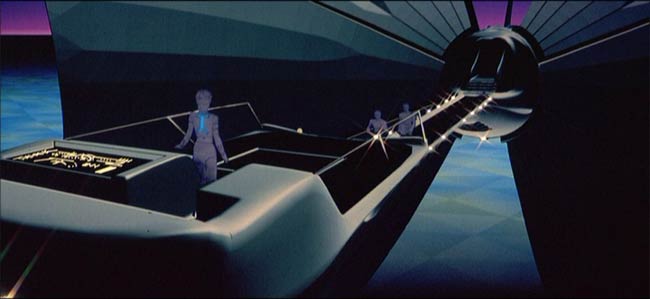
Tron has a rather silly aspect about it in that it continually uses computer terms in non-sensical ways. As steeped in computer-speak as we are today, these stick out like a sore thumb. However, at the time (1982), very few people would have noticed this. The idea was to just get the cyber-atmosphere permeating the movie, which Tron did most effectively. In setting the trend for most most cyberpunk movies that follow, neon colors are “In”, as is the idea of a single dominating color the permeates the movie - in Tron’s case we get mostly blue, along with red representing the bad guys.
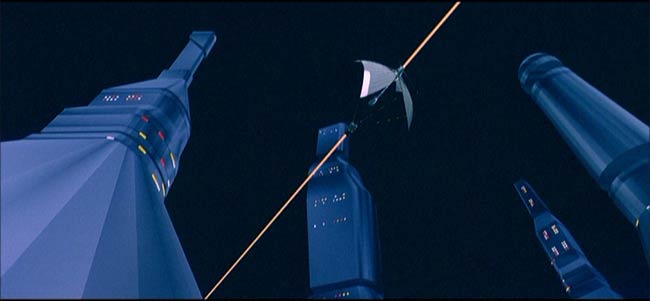
Yes the FX are dated now (God I hope so!). We’re talking about the real early days of computer graphics. Still, some of the shots still hold up well, and overall, the visuals are still very enjoyable. Tron is designed to have a sense of wonder about it - this still works. The car race game in particular is still VERY fun! Another thing that still works is the music accompanyment - Wendy Carlos’s synthesizer-laden soundtrack fits this movie perfectly.
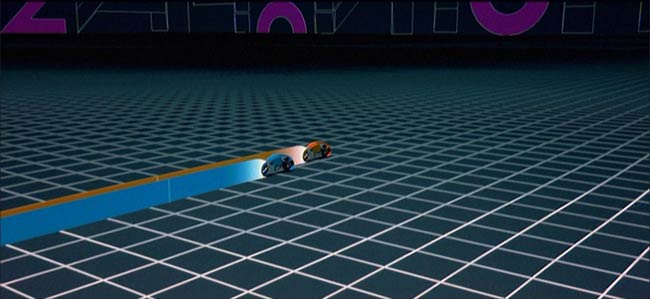
Overview: Jeff Bridges, Babylon Five’s Bruce Boxleitner, and David Warner as the evil bad guy (The exec Ed Dillinger, the game player Sark, and the Voice of the Master Control Program) all provide very fun performances. They are able to make this crazy environment work well enough that it still comes across as a rather cool cyberpunk flick. And truly, if you’re into VR cyberpunk movies, Tron is a MUST SEE - so much so that one point has added to this review score for its historical place in VR films.
~See movies similar to this one~
Tags: cyberpunk movie review Tron
Year: 1995
Directed by: Mamoru Oshii
Written by: Kazunori Itô, Shirow Masamune (Manga)
IMDB Reference
Degree of Cyberpunk Visuals: Very High
Correlation to Cyberpunk Themes: Very High
Key Cast Members:
Major Motoko Kusanagi: Atsuko Tanaka
Batô: Akio Ôtsuka
Section 9 Department Chief Aramaki: Tamio Ôki
Togusa: Kôichi Yamadera
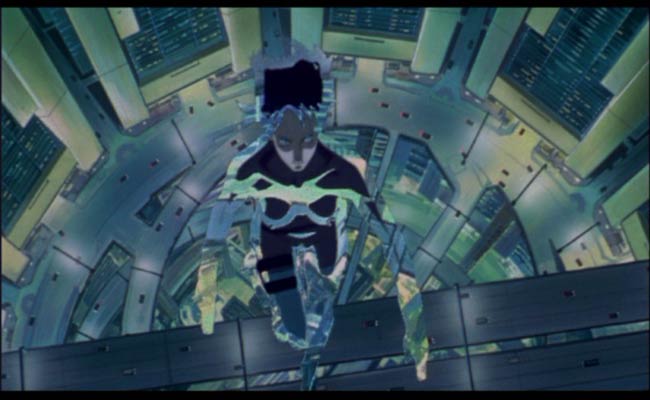
And where does the newborn go from here…the net is vast and infinite…
Overview: After Akira, a case can be made for Ghost in the Shell being the most influential anime ever. While Akira was the first anime to crack international markets, GITS rose anime to something “real,”, and opened the doors for events like Disney’s pursuit of Miyazaki, and eventually, the truly incredibly pace of anime we see today. More important for cyberpunk films, GITS provided a myriad of thoughts and visuals that have been expanded upon in virtually all subsequent cyberpunk animes. James Cameron refers to GITS as the first truly adult animation film to reach a level of literary and visual excellence.” In addition to a wonderfully complex and introspective story, we get heart-thumping, realistic action, all served up with some incredibly revolutionary animation techniques that places GITS on a juicy platter for all to enjoy.
~ Fair warning - there are a few plot spoilers below in the matrix discussion - I simply couldn’t write this, especially with linkages to the Matrix without including an interpretation of the ending of GITS. ~

GITS shows us a very realistic looking near future set in the year 2029. The visuals are intricately detailed and depict grunge settings next to the highly sanitized corporate world. In 2029, people have the ability to augment their bodies with cybernetic replacement parts. In some cases, people have almost fully replaced their human bodies, leaving only their brain encased in a cyborg shell. The brain is even augmented with hyper-intelligent access to knowledge and communication packages. But the person, and we use that term loosely now, still has a ghost, or soul if you will - an emergent property of life that separates a human from a robot. Even though the majority of their human material is replaced with a cyborg-like shell, if the individual retains their ghost, they still retain their personality and individuality - their humanity if you will.
This cyborg shell is not the same as a robot. The limbs and body still communicate with the brain in a digital nervous-system-like operation. If we include Masume Shirow’s vision (the writer for GITS), the cyborg’s sexual parts are even fully functional. This means that in essence, their cyborg shell aids in the creation of an individual’s ghost. While this is terrific, a downside is the ability for evil-doers to engage in Ghosthacking - or the taking over of someone’s perceptual control, or worse, augmenting their artificially enhanced memory.
The story centers on Major Motoko Kusanagi, an almost fully mechanically enhanced cyborg secret operative working for Section 9 - Japan’s anti-terrorism division. As the movie progresses Motoko and her cyborg partner, Batau start to uncover a plot involving another ministry that seems to be engaged in a cover-up. Eventually, we find that this cover-up involves a seemingly nefarious hacker named the Puppet Master. In pursuing the Puppet Master, Motoko finds out that all is not what it seems- that in fact the Puppet Master is a sentient program, and never had a body. More interesting, the Puppet Master has been looking for Motoko!
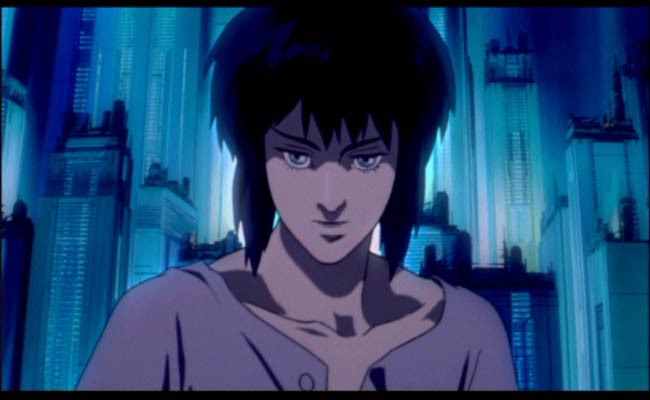
Revolutionizing Anime: Oshii revolutionized animation in GITS with a myriad of new and innovative computer graphics techniques. In short, Oshii pushed the boundaries for state-of-the art animation with GITS. Oshi scanned his animation cells in to a digital system so that he could import them into an editing suite to get all sorts of cool lens effects. For instance, in the above pic, Oshii is able to emulate a contra-pull type effect where the camera moves back, and the lens moves forward. In viewing this, the background expands while the foreground eerily stays in the same place. This works wonderfully for Motoko’s questioning of humanity speech. And this is only one of many interesting used of digital shots. Other techniques include interesting overlays that depict either brain activity or maps, for instance.
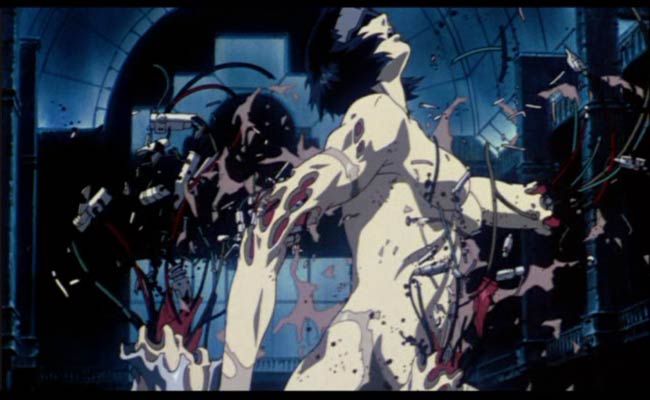
Questioning Humanity: Ghost in the Shell still provides anime’s the best examination in the questioning humanity. GITS is dominated by an ongoing discussion of what it means to be human and really, what it means to be alive. Is Motoko really still human? Even she doesn’t know the answer anymore, and actually questions whether she really has a ghost (how would she be able to differentiate a fake ghost from a real one?). This line of questioning is artfully developed in a way that makes Motoko the character in all of anime that I empathize with the most. You truly feel for the dilemma she finds herself facing.
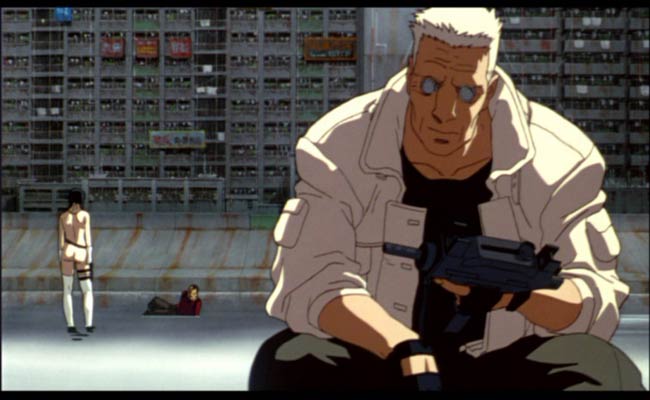
What is the Matrix? If we examine the Matrix, we find that both the visuals and storyline are heavily influenced by Ghost. There are some rather explicit visual “nods” in the first Matrix, including the opening digital sequence, Mr. Smith’s building jump where he breaks the concrete beneath him (this is virtually identical to Motoko pursuing the first puppet victim), and the shooting of the fruit stand where Neo is running near the end. On top of this, we have a reversal of roles in the Matrix, where Neo plays Motoko and Trinity emulates Batau. And again, the Wachowskis make no bones about where their influence came from - they, as much as anyone, have contributed to Ghost’s ever increasing popularity.
In looking at the storyline, we find even more interesting parallels. Ghost in the Shell ends with Motoko merging with the sentient program called the Puppet Master (Project 2501). This allows the Puppet Master produce a diversity of offspring that is simply not possible to do with copies alone. This has a direct parallel to the scifi view of Neo in the above review. While Ghost in the Shell 2: Innocence is the philosophical sequel to Avalon, the Matrix trilogy is just as clearly the sequel to Ghost in the Shell. Whereas GITS ends with this merging of a sentient program with a human ghost, the Matrix expands on this idea. We see Neo take the same journey, but in a very different way. He conducts this symbiotic merging over 3 movies whereas Motoko does this in a matter of minutes. We see Neo, through this merging of sentient program with a human, become the “one” - an omnipotent style being. This characterization is similar to the characterization that Batau gives of Motoko in GITS2 in his dogs and gods versus flawed humans speech.
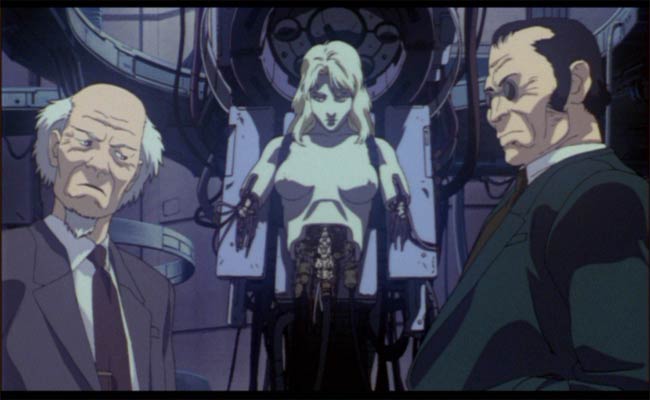
Also interesting is the linkage between the puppet master’s desire to digitally produce offspring with Neo’s reloading of the Matrix. The puppet master discusses this at the end of GITS in the “Life perpetuates itself through diversity and this includes the ability to sacrifice itself when necessary” monologue. If you trace the linkages, Neo’s reloading of the Matrix this is a method for the sentient program portion of Neo to create diversity and offspring. The merging of Neo allows the sentient program to grow and develop in ways simply not possible by itself. Familiarity with Neo’s Ghost allows it to make the changes necessary to correct the errors that build up in the current Matrix that prompt the battery people to disbelieve their surrounding.
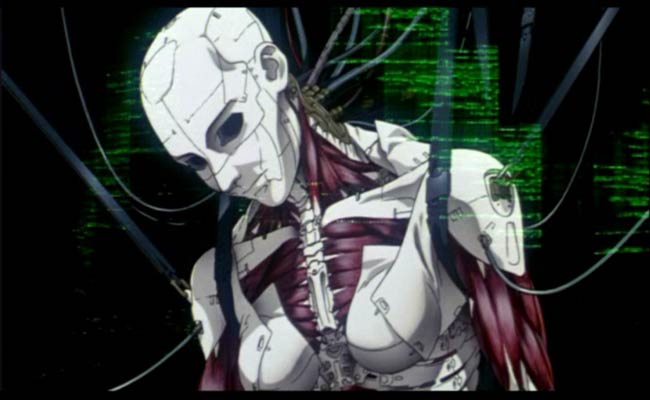
Finally, Ghost gives us a truly interesting vision of the future. We get sound astoundingly realistic and grungy cityscapes that are filled with the most impressive technological horrors. Is it truly a stretch to imagine that technology will augment our physical abilities? This is the bionic man taken to another level. On top of this, if we truly can learn to connect manufactured parts to our nervous system, is it really that far of a stretch to imagine that our brains become augmented? And over time, is it truly a stretch to believe that the line between humanity and robot won’t be blurred? GITS questions these articles of faith in such a believable way that we have seen a shift in our overall thinking on this issue.
The Bottom Line: Truly, even if you ignore all this philosophical stuff, Ghost in the Shell is simply an awesome movie! The action is terrific, the visuals are great, the soundtrack is devine…I could go on and on. If you just see one anime, Ghost in the Shell, still my favorite anime, is hands down the one to get.
Page 2: More GITS Screencaps –>>
~See movies similar to this one~
Tags: cyberpunk movie review anime ghost shell
Year: 1998
Directed by: Ryutaro Nakamura
Written by: Chiaki Konaka
IMDB Reference
Degree of Cyberpunk Visuals: High
Correlation to Cyberpunk Themes: Very High
Key Cast Members:
Lain Iwakura: Kaori Shimizu
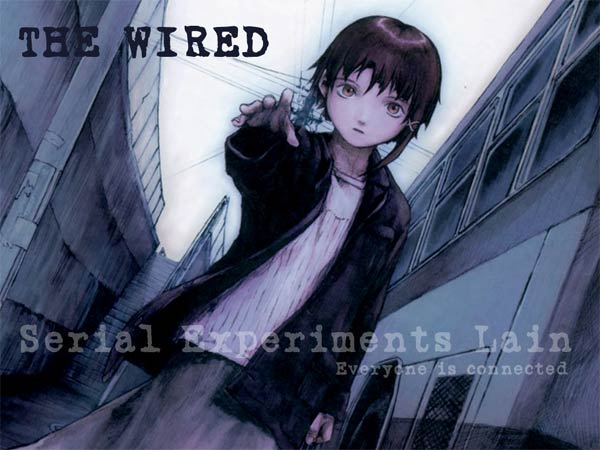
Overview: Serial Experiments Lain is a psychedelic, post-modern cyberpunk series that one wonders how the director ever managed to make. Lain centers on a very shy school girl who slowly begins to figure out that she is not what she seems to be. After getting a computer and connecting to the “wired,” something with is far more expansive than the internet, Lain begins to realize that she may not be human, and that truly, reality and the “self” is exists (or does not exist) on many different levels. As the story progresses, Lain “evolves” in terms of understanding what she is and her place in a very post-modern world. We also get many interesting side stories, including crime, teenage coming of age issues, and dastardly plots.
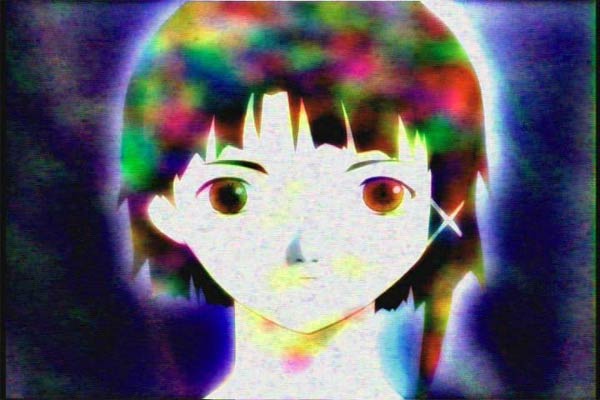
The pacing of Lain is just strange. Lain is NOT an action fest, nor is it by any means straight forward. Lain starts out rather slowly and gets weirder every episode. Truly, the story is told in a very “traditional” post-modern fashion in that we have fragmented vignettes structured in a seemingly random non-linear manner. Lain uses disconnected visuals to continually barrage the viewer with different textures, color schemes, and sounds. Yet over time, it becomes clear that the story is being spunk in seemingly a cyclical fashion, almost as if we are exploring a large Mandelbrot by starting at an outside spiral and slowly working our way around to the big picture. Each fragmented vignette gets added to until, at the end, we have a rather expansive tapestry to explore.

Many different and interesting philosophical ideas. But it is pure philosophical cyberpunk. Many key issues are discussed here, including:
- What constitutes “reality”?
- How real is time?
- What constitutes the “self” as a singular entity?
- What constitutes “God”?
- How are sentient programs different from humans?
- Is there such a thing as collective humanity?
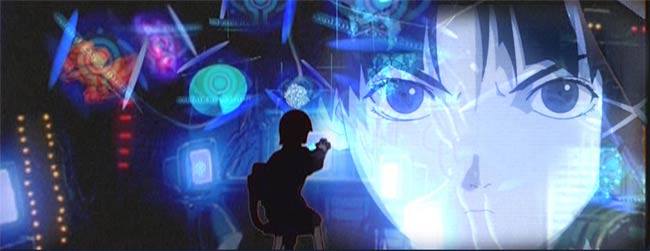
The visuals in Lain really aren’t there to “Wow” us as they are in some animes - instead they are often designed to provoke moods and thought patterns (BTW, there are so many screen caps available, that there was no need to take my own). Among the thought provoking visuals, we get:
- Psychedelic visions that explore multiple “selves” versus a singular “I”
- Juxtapositions of noise with false clarity
- Information Theory described visually
- An ever increasing feeling “disbelievability” each time the drab and normal school scene is shown.
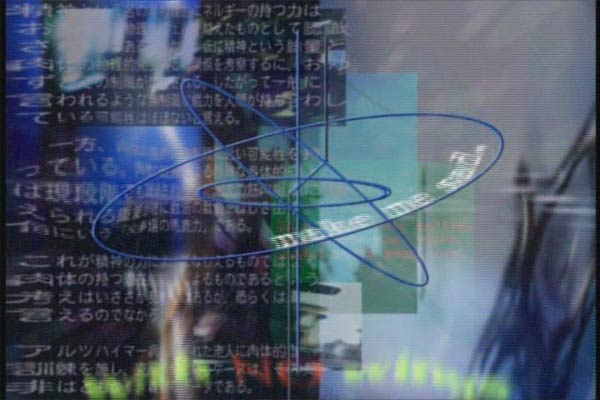
The Bottom Line: In the end, we are left with very open-ended thoughts. Serial Experiments Lain does not provide us with answers, instead, it opens us up to questions. And while I might argue that the post-modern pacing got too circular in places, and that I might argue the same tale could have been spun in half the time, the overall effect is rather extraordinary.
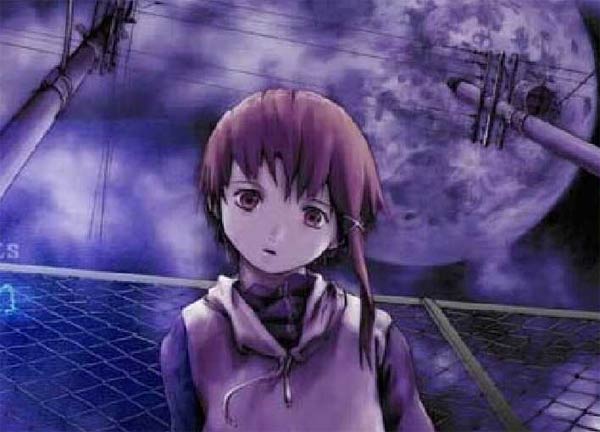
~See movies similar to this one~
Tags: cyberpunk movie review anime Serial Experiments Lain
Year: 1997
Directed by: Gabriele Salvatores
Written by: Pino Cacucci, Gloria Corica, Gabriele Salvatores
IMDB Reference
Degree of Cyberpunk Visuals: Very High
Correlation to Cyberpunk Themes: High
Key Cast Members:
Jimi Dini: Christopher Lambert
Solo: Diego Abatantuono
Naima: Stefania Rocca
Joystick: Sergio Rubini
Lisa: Emmanuelle Seigner
~Revised Review: The star rating is for the Italian language version. ~
They US Region 1 English Dubbing version only merits 6 stars
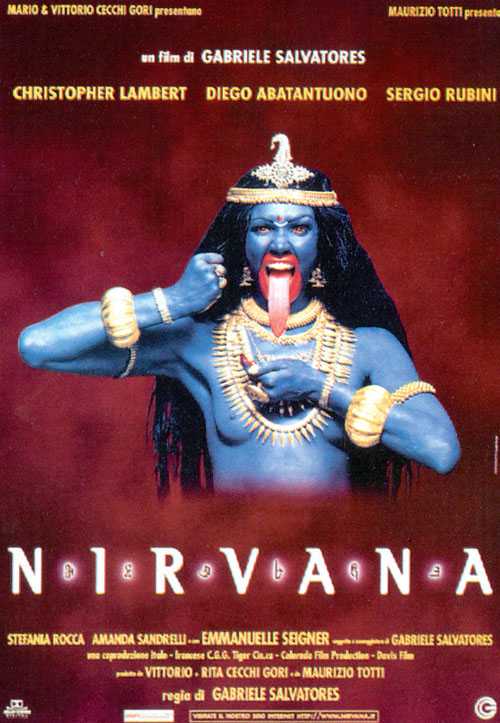
If you aren’t buying this cover, you probably aren’t getting a DVD with Italion (with English Subtitles). The US version only has English Dubbing.
Overview: Previously, my review of Nirvana, which was based on the Region 1 English dubbing only copy started as follows:
All in all a decent cyberpunk flick from Italy, but unfortunately suffers horribly from bad dubbing. The dubbing here is as bad as your average anime dubbing, and unfortunately here in the US, this is all we get.  I wish I could get a copy of this in Italian with subtitles - if I did, I’m sure this would shoot up significantly on my cyberpunk list, but alas… I wish I could get a copy of this in Italian with subtitles - if I did, I’m sure this would shoot up significantly on my cyberpunk list, but alas…
Now that I’ve purchased the Italian copy (which set me back about $30 bucks!), I still agree with my comments above - the dubbing ruined it. Truly. In Italian, the movie has the necessary spark of energy and emotion missing from the dubbed version. The story itself always held up at least decently well. What was missing is any connection to the actors. The Italian version fixes this. The picture below really captures the colorization of this film -we get lots of drab, dirty settings with shocking neon colors intermixed.
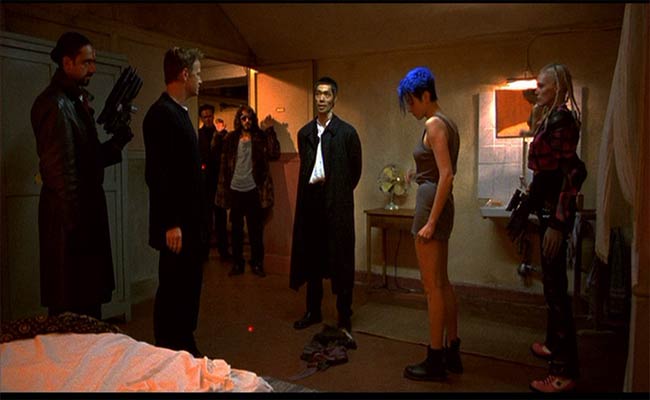
The Story: Nirvana is NOT Tron meets Blade Runner Meets Matrix as the cheesy tagline on US version of the DVD suggests. However, Nirvana is a pretty good low-budget cyberpunk flick with a strange virtual reality (VR) angle. Jimi (Lambert) is a computer programmer who is working on a VR simulation game with very realistic seeming characters. Somehow a strange virus infects his game and turns one of his VR characters into a self-aware program. The VR character has to “relive” the game sequence almost in a groundhog day type fashion, only each time he has to figure out how to avoid getting killed so he can progress further into the plot. The game is 3 days away from being distributed everywhere and the program doesn’t want to be duplicated everywhere, and worse, feels trapped in a nightmare. Lambert feels bad for the VR character and starts working to get the program deleted from corporate.
Unfortunately, this involves hacking into the corporation’s corporate system. To do this, Jimi has to go to the seedy part of town outside the barriers to find the expertise he needs. Jimi is also distraught by recently losing the love of his life, Lisa, who left him for still undetermined reasons. Jimi stumbles upon Joystick, a former cowboy (hacker), who has lost his eyesight and now has to rely on failing eye implants to see. Jimi tells Joystick that the corporate system is also home to millions in illegal funds, that can be stolen with the right hack. Joystick and Jimi work out a plan to break into the corporate system. Along the way, they meet up with Naima, a computer expert, who also has a way of bringing Jimi back to Lisa. Unfortunately, the corporate agents are on Jimi’s trail, and want the final verison of the game.
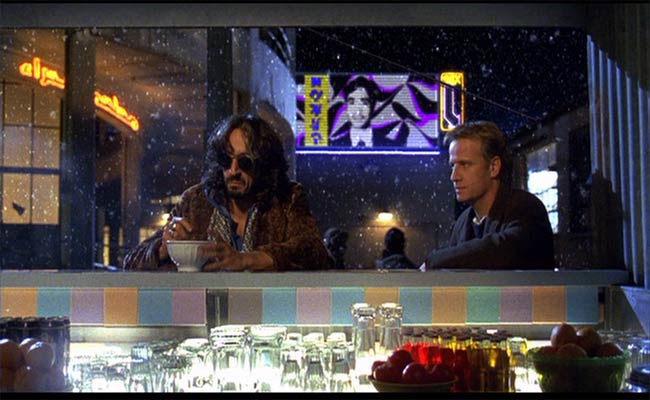
The Atmosphere: The atmosphere is similar to Blade Runner in the sense that its a seedy futuristic setting. More interesting is the Neuromancer-style cowboy hacking that Nirvana embraces. The idea that we can allow our consciousness to “ride the net” in order to break in to data systems is one that currently doesn’t jive with modern computing, but it is very motivating. There are also a number of cool cyberpunk elements in Nirvana, including eye implants, hard drives embedded in people’s brains, etc. I’ve gone ahead and made a few screencaps of this to give you a better idea of the visuals:
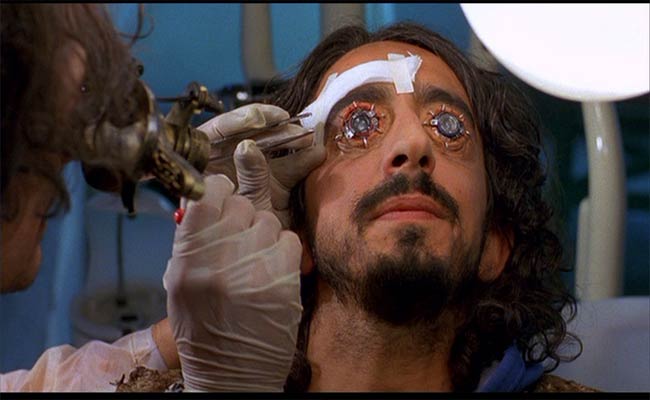
Just your average eye surgery…
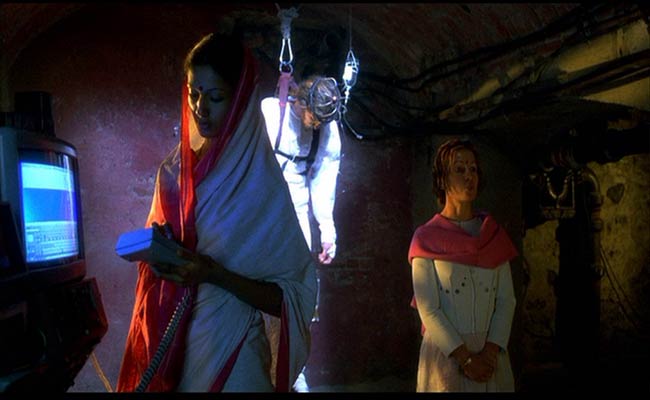
There are lots of Indian visuals here. This is really the setting.
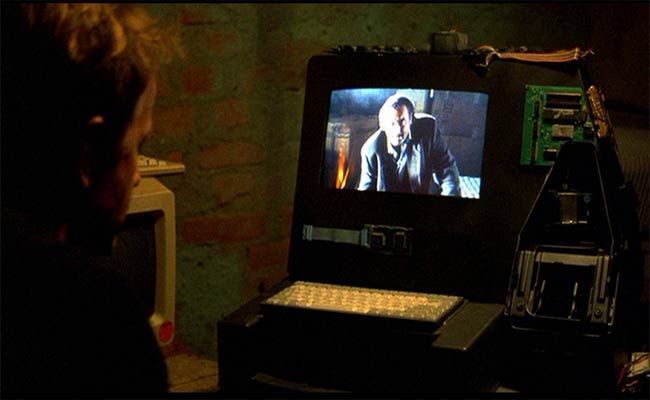
This is one of the many sequences of Lambert talking to his self-aware VR game character.
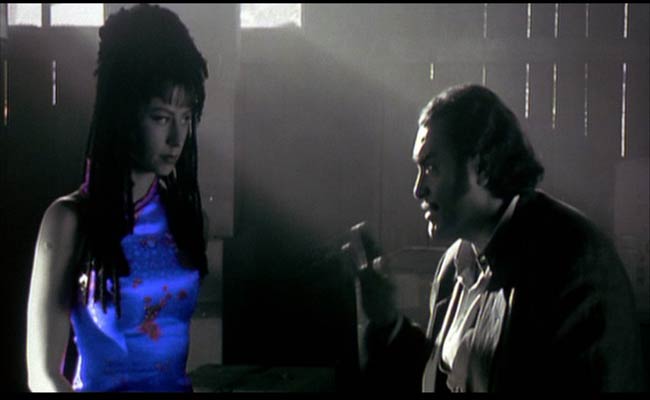
Here’s our self-aware VR character, trying to convince a non-self-aware VR whore that they are not real. This chick’s dress changes color every few seconds.

This chick is implanting a memory capture of Lambert’s wife’s memories.
The Bottom Line: If you’re looking for a really good low-budget cyberpunk movie, Nirvana is your flick - AS LONG AS you get the italian version. I’m not sure it’s worth $30 bucks, but it’s LOTS better than the dubbed version. Truly, I don’t get US DVD distributors sometimes, but hopefully this trend towards dubbing is slowly changing. Even if you are stuck with the dubbing, which pretty much ruins the story, at least the visuals are more than decent. On top of this, I truly love Lambert, so I was able to put up with it.
PS - thanks again to the comments below that enabled me to find a copy of this in Italian 
~See movies similar to this one~
|































